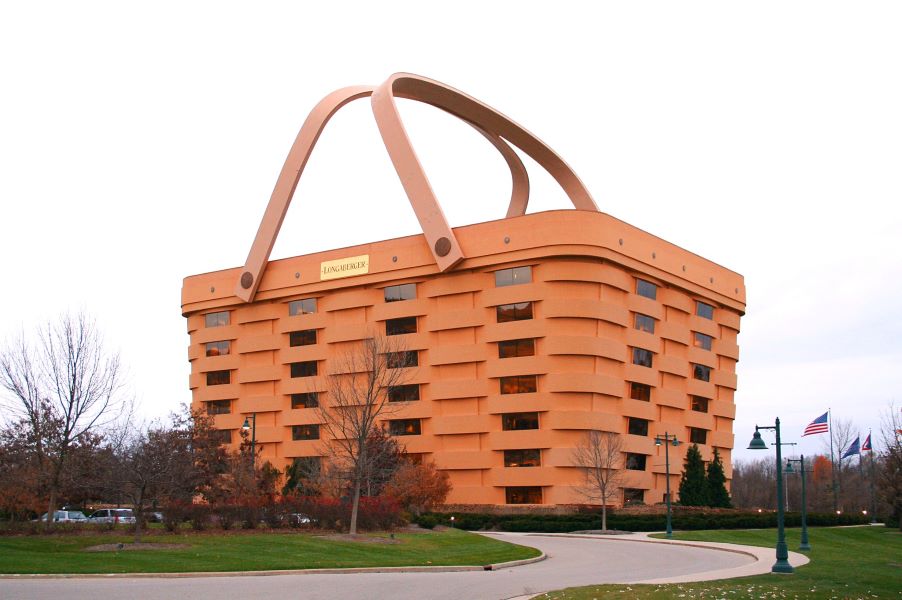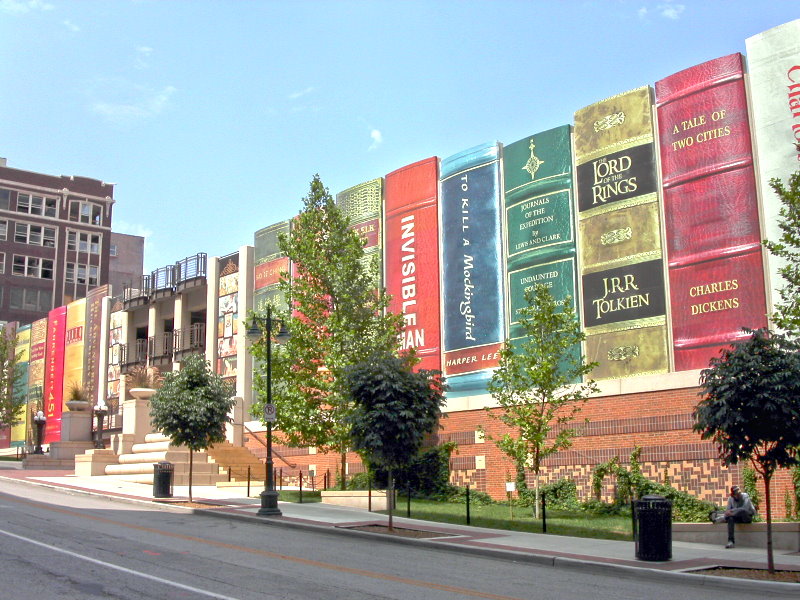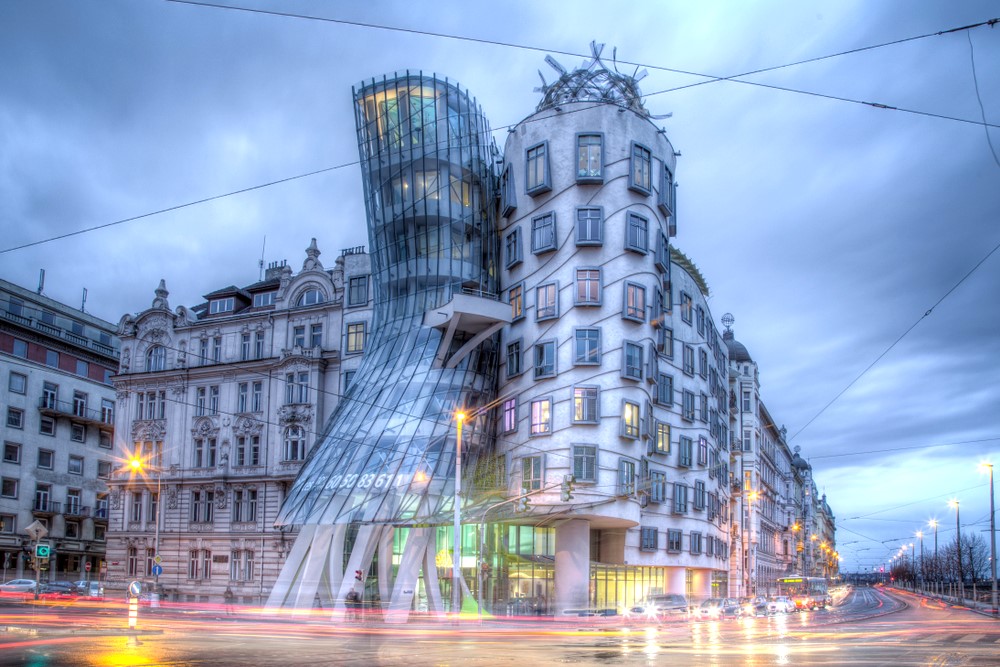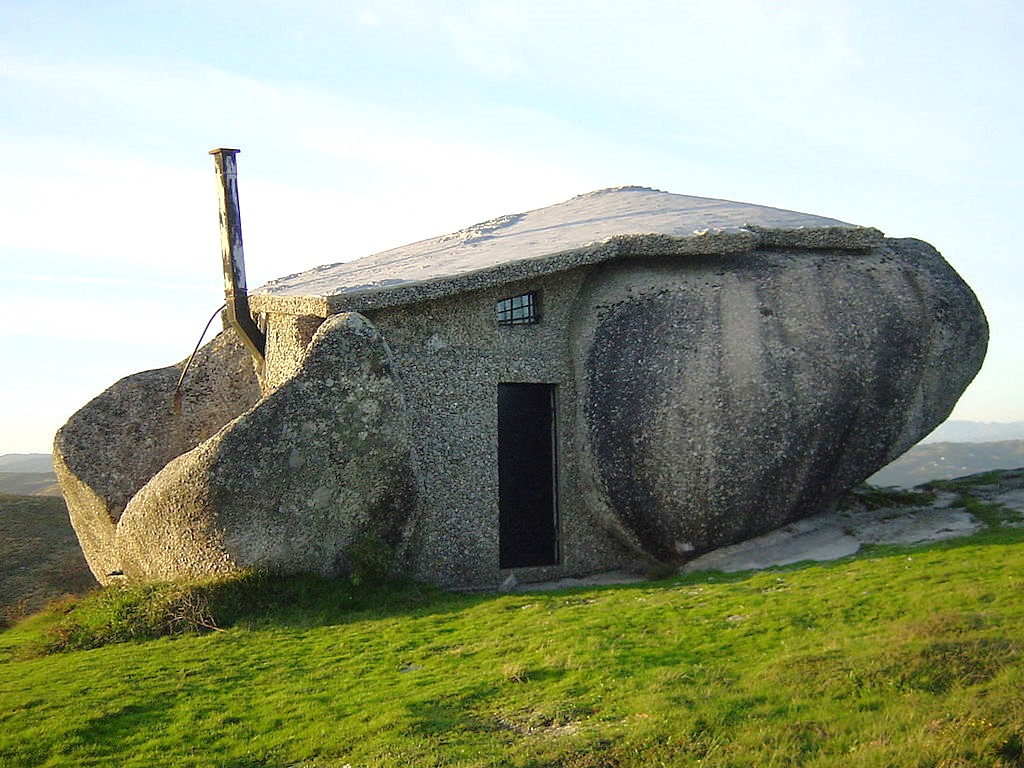Travelers today seek experiences that go beyond the ordinary, venturing far from the beaten path to encounter the unexpected and the extraordinary. Architecture, in its most daring forms, offers just such an opportunity. As one journeys across continents, it becomes clear that the world’s skylines aren’t just defined by towering skyscrapers and historic monuments, but also by an array of buildings that challenge conventional aesthetics and practical design.
These architectural marvels often reflect the culture, innovation, and humor of the places they stand. From buildings that take inspiration from local folklore to modern constructions that defy physics with their angles and illusions, the variety is almost boundless. Such structures not only serve practical purposes but also act as large-scale public art installations that provoke curiosity and awe.
The Basket Building — Newark, Ohio

Longaberger Headquarters, Newark, Ohio by Ali Eminov licensed under CC BY-NC 2.0 DEED
Less than an hour east of Columbus, the “Basket Building” in Newark, Ohio, is an architectural tribute to the craftsmanship of the Longaberger Basket Company, once serving as its headquarters. Designed to replicate one of the company’s iconic woven baskets, this building stands out as a distinctive example of novelty architecture. The structure is remarkably detailed, complete with enormous handles that arch over the rooftop, which can be illuminated at night to spectacular effect. Spanning a vast 180,000 square feet, this office building not only captures the imagination but also embodies the spirit of the brand it was built to represent.
After the company relocated, the Basket Building has continued to attract curiosity and admiration from architects, photographers, and travelers alike. It remains a beloved icon in Newark, Ohio, celebrated for its imaginative design and the whimsical charm it adds to the landscape, proving that architecture can be as playful as it is functional.
Kansas City Public Library Parking Garage — Kansas City, Missouri

Parking Garage, Kansas City Public Library by gritts1 licensed under CC BY-NC-SA 2.0 DEED
The Kansas City Public Library Parking Garage in Kansas City, Missouri transforms a conventional parking facility into an awe-inspiring celebration of literature. Known locally as the “Community Bookshelf,” this garage resembles a shelf of giant books. The façade of the garage is adorned with 22 enormous book spines, each measuring approximately 25 feet in height. These spines display a diverse array of literary classics selected by the local community, featuring titles from Romeo and Juliet to The Lord of the Rings.
This innovative design not only beautifies an otherwise utilitarian structure but also reflects the city’s deep appreciation for reading and the arts. As a functional piece of public art, it draws visitors and residents alike, who often stop to admire the sheer creativity and communal spirit embodied in the building.
Crooked House — Sopot, Poland

Krzywy Domek, Sopot, Poland by Timon91 licensed under CC BY-NC-SA 2.0 DEED
The Crooked House in Sopot, Poland, is a surreal architectural creation that seems to have sprung from the pages of a fairy tale. Inspired by the fantastical illustrations of Jan Marcin Szancer and the imaginative tales of Per Dahlberg, this building distorts reality with its curiously undulating walls and windows. The structure gives the impression of melting into the surroundings, playing tricks on the eyes of onlookers with its bending facades and twisted lines.
Visitors often feel as though they are walking into a dream, as every angle offers a new perspective and a fresh surprise. The design not only captivates those who see it but also blends seamlessly into the vibrant, artistic spirit of Sopot. The Crooked House is both a playful masterpiece and a mesmerizing landmark that enchants and delights everyone who encounters its distinctive charm.
Helix Bridge — Singapore

Helix Bridge, Singapore
The Helix Bridge in Singapore is an iconic landmark, not just for its utility but for its striking design inspired by the structure of DNA. This pedestrian bridge showcases an intricate double-helix architecture, a design that merges scientific inspiration with functional elegance. By night, the bridge transforms into a visual spectacle, illuminated by a series of LED lights that highlight its futuristic curves and spirals, casting a radiant glow across the Singapore River.
The bridge provides a vital connection between the Marina Centre and the Marina South in the heart of the city, but also serves as a favorite spot for both photographers and sightseers. The Helix Bridge is celebrated for its integration of art and engineering, offering both a scenic walkway and a symbolic reflection of the life sciences, driving home Singapore’s reputation as city of architectural innovation.
Montaña Mágica Lodge — Huilo Huilo, Chile

Magic Mountain Hotel, Chile by Tony Guyton licensed under CC BY 2.0 DEED
The Montaña Mágica Lodge in Huilo Huilo, Chile, offers an immersive nature experience with its remarkable volcano-shaped structure. This enchanting hotel not only mimics the form of a volcano but also features a daily water “eruption,” creating a spectacle that blends the mystical with the natural. Set deep within a private natural reserve, the lodge is enveloped by lush vegetation, making it appear as if it has sprung organically from the earth itself.
Windows peek out from a moss-covered exterior, integrating the building into the surrounding forest. This design choice enhances the sense of being intimately connected with the natural world. The lodge provides guests with a serene escape where the lines between man-made structures and nature blur, offering a peaceful retreat that feels like a part of the landscape.
Capital Gate — Abu Dhabi, UAE

Capital Gate, Abu Dhabi, UAE
Capital Gate in Abu Dhabi is a testament to engineering ingenuity, holding the record for the world’s furthest leaning human-made tower. With an intentional lean of 18 degrees westward, it far surpasses the iconic Leaning Tower of Pisa in its tilt, achieving this through advanced engineering techniques and cutting-edge design. The building’s striking posture defines the city’s skyline.
Capital Gate’s distinctive structure is supported by a robust steel spine, which anchors it securely while allowing for its dramatic lean. This feature, along with its diagrid façade, contributes to its aesthetic appeal and enhances its structural integrity. As a standout feature of the Abu Dhabi skyline, Capital Gate attracts visitors and professionals alike, serving as an iconic symbol of modern architectural trends and the innovative future of building design.
Dancing House — Prague, Czech Republic

“Dancing House,” Prague, Czech Republic
The Dancing House in Prague, Czech Republic, is a stunning example of deconstructivist architecture that stands out amid the city’s historic skyline. Nicknamed “Fred and Ginger,” after the legendary dance duo Fred Astaire and Ginger Rogers, this building captivates passersby with its dynamic appearance, seeming to be in motion. Its design features undulating curves and twisted forms that mimic two figures dancing, infusing a sense of rhythm and flow into the structure.
Situated on a riverfront plot, the Dancing House marks a stark contrast to the Baroque, Gothic, and Art Nouveau buildings that typically characterize Prague’s architectural heritage. This modern architectural gem serves as an office building but also as a cultural landmark, drawing attention and debate about contemporary architecture’s place in historic environments.
Robot Building — Bangkok, Thailand

Robot Building by Oran Viriyincy licensed under CC BY-SA 2.0 DEED
The Robot Building in Bangkok, Thailand, is an architectural marvel that stands out in the Sathorn business district. Designed by the renowned architect Sumet Jumsai, this building draws inspiration from technology and toys, crafted to resemble a giant robot. The eyes of the robot function as windows, providing a whimsical yet functional element, while the antennas enhance its robotic appearance, contributing to its distinctive silhouette against the city skyline. This building was conceived as a playful critique of the serious and utilitarian nature of commercial architecture. With its distinctive design, the Robot Building challenges conventional skyscraper aesthetics and injects a sense of fun and creativity into the urban landscape.
You Might Also Enjoy: Offbeat Travel: The Crazy House in Vietnam
Stone House — Guimarães, Portugal

Casa da Pedra em Fafe by Feliciano Guimarães licensed under CC BY 2.0 DEED
The Stone House, or “Casa do Penedo” (‘House of the Rock’), in Guimarães, Portugal, is an architectural curiosity that merges the ruggedness of nature with human craftsmanship. Built in the 1970s, this remarkable dwelling is nestled between four large boulders that were naturally present on the site. The house’s design and materials make it look as though it has been lifted straight from the Stone Age, reminiscent of a dwelling from “The Flintstones.”
Despite its prehistoric appearance, the Stone House is equipped with modern amenities that make it comfortable for contemporary living. Inside, it features a cozy fireplace and even a swimming pool that has been ingeniously carved into one of the existing rocks. This blend of natural elements with modern comforts makes the Stone House a fascinating study in contrasts and a testament to imaginative architectural design that respects and utilizes its natural environment.
FAQs:
Q: What are the best times of year to visit these architectural sites?
A: Most of these sites can be visited year-round, but the best time is generally during the milder spring or fall months to avoid extreme weather conditions, especially in locations like Bangkok or Abu Dhabi.
Q: Are there guided tours available for these buildings?
A: Many of these buildings offer guided tours. It’s best to check the specific building’s official website or contact local tourism offices for tour availability and schedules.
Q: Can you enter all these buildings, or are some only viewable from the outside?
A: While some buildings like the Kansas City Public Library Parking Garage and the Helix Bridge are open to the public, others may have restrictions or are only viewable from the outside. Always check ahead for access details.
Q: Is there an admission fee for any of these sites?
A: Public structures like bridges and parking garages are usually free to explore. However, buildings used for commercial purposes might only be accessible through guided tours which could have a fee.
Q: What are the photography restrictions at these sites?
A: Photography is generally allowed from public spaces, but for commercial shoots or inside private buildings, permission may be required. Always check the site’s photography policy online or inquire on-site.
Q: How accessible are these architectural sites for travelers with disabilities?
A: Accessibility varies widely. Newly built or recently renovated sites are more likely to be accessible. Specific accessibility information is typically available on the official website or by contacting the site directly.
Q: Are there any recommended accommodations near these architectural wonders?
A: Most of these locations are in or near major cities, so there are numerous accommodation options ranging from luxury hotels to budget hostels. Online travel platforms can provide options based on proximity and budget.
Have you ever seen any of these weird buildings live? Tell us about it in the comments below!


Leave a Reply